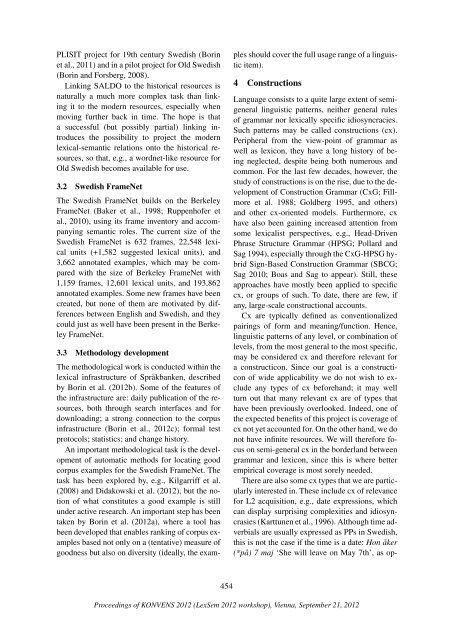Proceedings - Österreichische Gesellschaft für Artificial Intelligence
Proceedings - Österreichische Gesellschaft für Artificial Intelligence
Proceedings - Österreichische Gesellschaft für Artificial Intelligence
You also want an ePaper? Increase the reach of your titles
YUMPU automatically turns print PDFs into web optimized ePapers that Google loves.
PLISIT project for 19th century Swedish (Borin<br />
et al., 2011) and in a pilot project for Old Swedish<br />
(Borin and Forsberg, 2008).<br />
Linking SALDO to the historical resources is<br />
naturally a much more complex task than linking<br />
it to the modern resources, especially when<br />
moving further back in time. The hope is that<br />
a successful (but possibly partial) linking introduces<br />
the possibility to project the modern<br />
lexical-semantic relations onto the historical resources,<br />
so that, e.g., a wordnet-like resource for<br />
Old Swedish becomes available for use.<br />
3.2 Swedish FrameNet<br />
The Swedish FrameNet builds on the Berkeley<br />
FrameNet (Baker et al., 1998; Ruppenhofer et<br />
al., 2010), using its frame inventory and accompanying<br />
semantic roles. The current size of the<br />
Swedish FrameNet is 632 frames, 22,548 lexical<br />
units (+1,582 suggested lexical units), and<br />
3,662 annotated examples, which may be compared<br />
with the size of Berkeley FrameNet with<br />
1,159 frames, 12,601 lexical units, and 193,862<br />
annotated examples. Some new frames have been<br />
created, but none of them are motivated by differences<br />
between English and Swedish, and they<br />
could just as well have been present in the Berkeley<br />
FrameNet.<br />
3.3 Methodology development<br />
The methodological work is conducted within the<br />
lexical infrastructure of Språkbanken, described<br />
by Borin et al. (2012b). Some of the features of<br />
the infrastructure are: daily publication of the resources,<br />
both through search interfaces and for<br />
downloading; a strong connection to the corpus<br />
infrastructure (Borin et al., 2012c); formal test<br />
protocols; statistics; and change history.<br />
An important methodological task is the development<br />
of automatic methods for locating good<br />
corpus examples for the Swedish FrameNet. The<br />
task has been explored by, e.g., Kilgarriff et al.<br />
(2008) and Didakowski et al. (2012), but the notion<br />
of what constitutes a good example is still<br />
under active research. An important step has been<br />
taken by Borin et al. (2012a), where a tool has<br />
been developed that enables ranking of corpus examples<br />
based not only on a (tentative) measure of<br />
goodness but also on diversity (ideally, the examples<br />
should cover the full usage range of a linguistic<br />
item).<br />
4 Constructions<br />
Language consists to a quite large extent of semigeneral<br />
linguistic patterns, neither general rules<br />
of grammar nor lexically specific idiosyncracies.<br />
Such patterns may be called constructions (cx).<br />
Peripheral from the view-point of grammar as<br />
well as lexicon, they have a long history of being<br />
neglected, despite being both numerous and<br />
common. For the last few decades, however, the<br />
study of constructions is on the rise, due to the development<br />
of Construction Grammar (CxG; Fillmore<br />
et al. 1988; Goldberg 1995, and others)<br />
and other cx-oriented models. Furthermore, cx<br />
have also been gaining increased attention from<br />
some lexicalist perspectives, e.g., Head-Driven<br />
Phrase Structure Grammar (HPSG; Pollard and<br />
Sag 1994), especially through the CxG-HPSG hybrid<br />
Sign-Based Construction Grammar (SBCG;<br />
Sag 2010; Boas and Sag to appear). Still, these<br />
approaches have mostly been applied to specific<br />
cx, or groups of such. To date, there are few, if<br />
any, large-scale constructional accounts.<br />
Cx are typically defined as conventionalized<br />
pairings of form and meaning/function. Hence,<br />
linguistic patterns of any level, or combination of<br />
levels, from the most general to the most specific,<br />
may be considered cx and therefore relevant for<br />
a constructicon. Since our goal is a constructicon<br />
of wide applicability we do not wish to exclude<br />
any types of cx beforehand; it may well<br />
turn out that many relevant cx are of types that<br />
have been previously overlooked. Indeed, one of<br />
the expected benefits of this project is coverage of<br />
cx not yet accounted for. On the other hand, we do<br />
not have infinite resources. We will therefore focus<br />
on semi-general cx in the borderland between<br />
grammar and lexicon, since this is where better<br />
empirical coverage is most sorely needed.<br />
There are also some cx types that we are particularly<br />
interested in. These include cx of relevance<br />
for L2 acquisition, e.g., date expressions, which<br />
can display surprising complexities and idiosyncrasies<br />
(Karttunen et al., 1996). Although time adverbials<br />
are usually expressed as PPs in Swedish,<br />
this is not the case if the time is a date: Hon åker<br />
(*på) 7 maj ‘She will leave on May 7th’, as op-<br />
454<br />
<strong>Proceedings</strong> of KONVENS 2012 (LexSem 2012 workshop), Vienna, September 21, 2012





